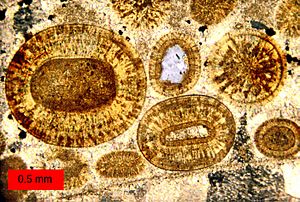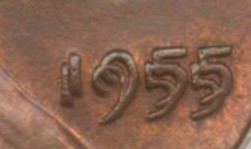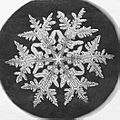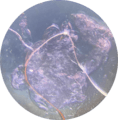Micrograph facts for kids
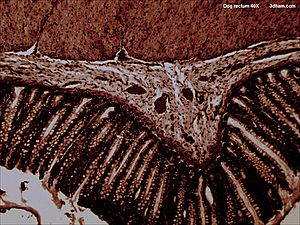
A micrograph or photomicrograph is a photograph or digital image taken through a microscope or similar device to show a magnified image of an object. This is opposed to a macrograph or photomacrograph, an image which is also taken on a microscope but is only slightly magnified, usually less than 10 times. Micrography is the practice or art of using microscopes to make photographs.
A micrograph contains extensive details of microstructure. A wealth of information can be obtained from a simple micrograph like behavior of the material under different conditions, the phases found in the system, failure analysis, grain size estimation, elemental analysis and so on. Micrographs are widely used in all fields of microscopy.
Contents
Types
Photomicrograph
A light micrograph or photomicrograph is a micrograph prepared using an optical microscope, a process referred to as photomicroscopy. At a basic level, photomicroscopy may be performed simply by connecting a camera to a microscope, thereby enabling the user to take photographs at reasonably high magnification.
Scientific use began in England in 1850 by Prof Richard Hill Norris FRSE for his studies of blood cells.
Roman Vishniac was a pioneer in the field of photomicroscopy, specializing in the photography of living creatures in full motion. He also made major developments in light-interruption photography and color photomicroscopy.
Photomicrographs may also be obtained using a USB microscope attached directly to a home computer or laptop.
Electron micrograph
An electron micrograph is a micrograph prepared using an electron microscope.
Magnification and micron bars
Micrographs usually have micron bars, or magnification ratios, or both.
Magnification is a ratio between the size of an object on a picture and its real size. Unfortunately, magnification can be a misleading parameter as it depends on the final size of a printed picture and therefore varies with picture size. A scale bar, or micron bar, is a line of known length displayed on a picture. The bar can be used for measurements on a picture. When the picture is resized the bar is also resized making it possible to recalculate the magnification. Ideally, all pictures destined for publication/presentation should be supplied with a scale bar; the magnification ratio is optional. All but one (limestone) of the micrographs presented on this page do not have a micron bar; supplied magnification ratios are likely incorrect, as they were not calculated for pictures at the present size.
Micrography as art
The microscope has been mainly used for scientific discovery. It has also been linked to the arts since its invention in the 17th century. Early adopters of the microscope, such as Robert Hooke and Antonie van Leeuwenhoek, were excellent illustrators. After the invention of photography in the 1820s the microscope was later combined with the camera to take pictures instead of relying on an artistic rendering.
Since the early 1970s individuals have been using the microscope as an artistic instrument. Websites and traveling art exhibits such as the Nikon Small World and Olympus Bioscapes have featured a range of images for the sole purpose of artistic enjoyment. Some collaborative groups, such as the Paper Project have also incorporated microscopic imagery into tactile art pieces as well as 3D immersive rooms and dance performances.
Gallery
-
Measurements of a large amoeba at 400x.
-
Snowflake micrograph by Wilson Bentley, 1890
-
An image taken from a scanning electron microscope
Images for kids
See also
 In Spanish: Micrografía para niños
In Spanish: Micrografía para niños



